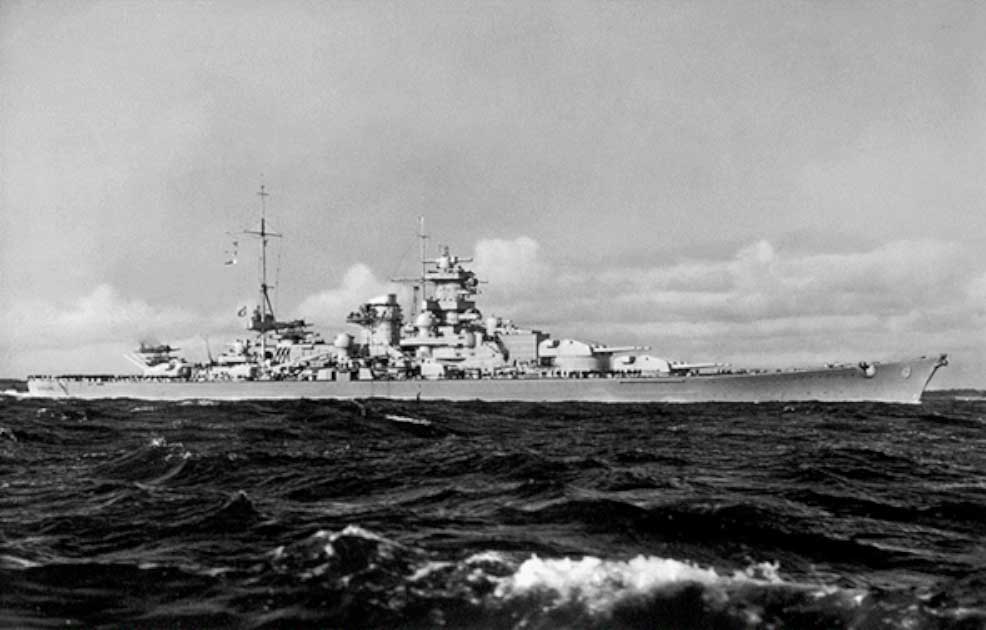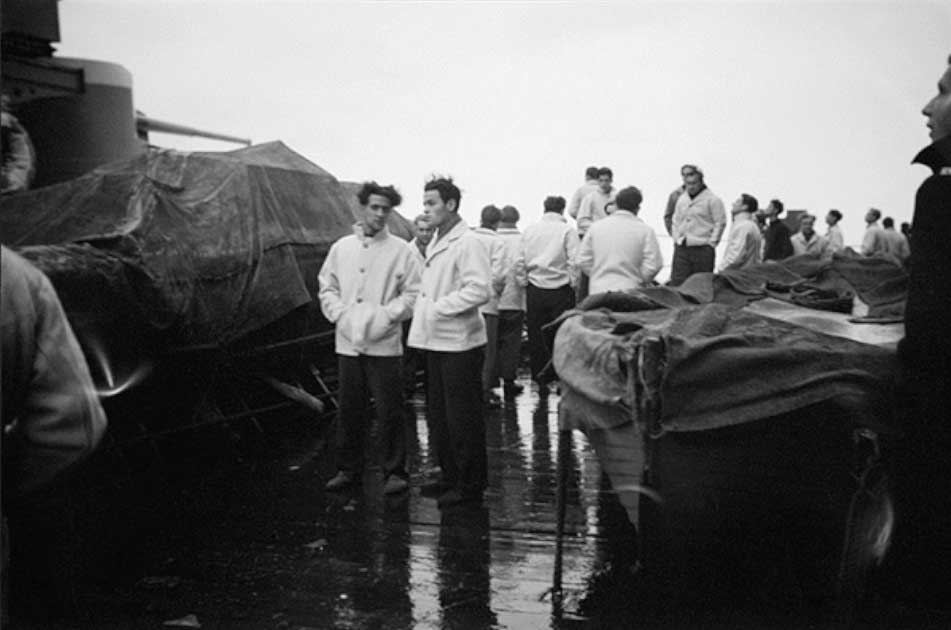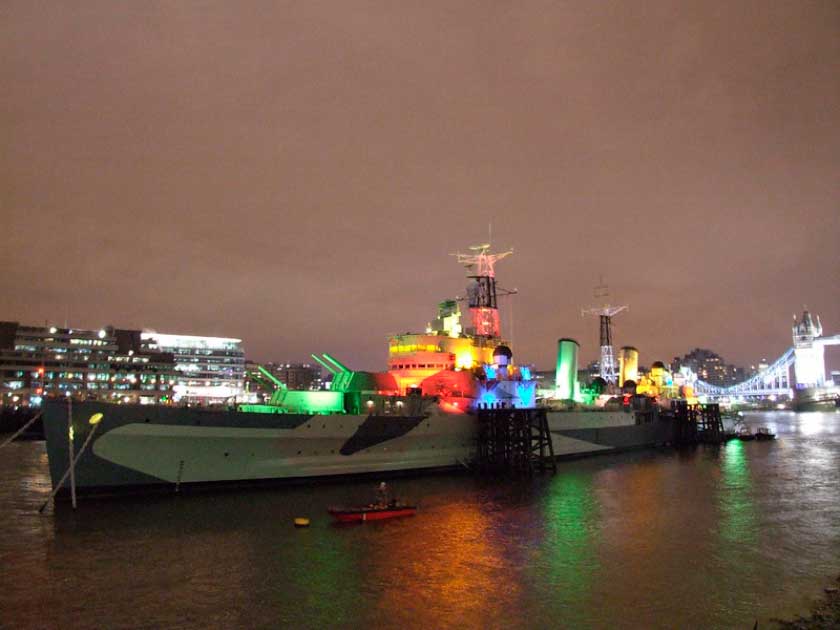In the center of London, between London Bridge and Tower Bridge and close to the old city, a warship sits at anchor. Familiar to residents, the light cruiser HMS Belfast was chosen to be preserved as a museum ship.
Why Belfast? In the Second World War, such ships played an instrumental role in striking the enemy. In the Battle of the North Cape, a major naval battle, HMS Belfast made history, and changed the course of the war.
What happened in the frozen waters of the far north to cause such a seismic event? What did Belfast do which singled her out from all the other bigger, more storied and more illustrious ships of the Royal Navy?
HMS Belfast Today
HMS Belfast has been permanently moored on the river Thames in London, the most important Royal Navy warship still surviving from the Second World War. Despite the huge loss of manpower and material at sea during the war, HMS Belfast emerged victorious and intact.
Over the long lifespan, the ship has witnessed various events and occurrences that are significant to date. As a sign of respect and appreciation, HMS Belfast has been transformed into a floating museum. It serves as the jewel of the Imperial War Museum, and by exploring the warship, one can get a glimpse into life on board during WWII.
One of the surprising things that many miss when first seeing Belfast is the angle of her forward guns, aimed high into the air and to the right. In fact, her guns have a target: they are trained on the first gas station on the M1, the principal motorway running north out of London. Belfast could fire her guns over the entirety of the great city to hit something as small as a service station on the other side.
Why was she Preserved?
HMS Belfast has been preserved as a museum ship because of its key role in the Second World War. She not only succeeded in surviving the gruesome war but also led to the sinking of Scharnhorst, the lead warship of Germans, in what is known as the Battle of the North Cape.
- How Do You Sink The Bismarck? A WWII Conundrum
- The Nazi V-3 Cannon: Could this “Vengeance” Weapon Have Destroyed London?
The Nazis had four great battleships in the Second World War, and containing the threat they posed was critical to Allied strategy as it allowed supply convoys to reach Europe. These were the Bismarck, the Tirpitz, the Gneisenau, and the Scharnhorst.

By December 1943 only the Scharnhorst remained. The Gneisenau had been decommissioned after suffering heavy damage due to British air raids while in dry dock, and Bismarck had been lost in the Atlantic. The Tirpitz was still afloat, but heavily damaged by mines.
She may have been alone but she was also a formidable threat, heavily armored and heavily armed. However, Scharnhorst’s days were numbered. In her final voyage, Scharnhorst was on a mission to destroy Allied convoys off the coast of Norway, to prevent supplies reaching the Soviet Union.
The Allies had been searching for Scharnhorst for some time, and this was to be their lucky day. Codebreaking intelligence has revealed which convoy the great battleship was hunting, and a British task force of one battleship, one cruiser and four destroyers left port to catch her. Belfast was not among them.
Instead Belfast, along with two other ships, was in fact escorting the convoy, a task they completed successfully. Scharnhorst had missed her target, and with the empty convoy safely diverted to avoid contact it was Belfast who first found the battleship on her radar screen, on 26th December 1943.
Scharnhorst was all alone, but massively outclassed the British light cruiser. Even with her escort cruisers, HMS Norfolk and HMS Suffolk, Belfast faced a stiff fight and a slippery opponent.
The first success went to the British, and after taking two hits, Scharnhorst turned to flee. Ever a fast ship, it was very likely that she could slip away from contact and disappear, thwarting the British and denying them their prize. But she was not prepared for the sheer tenacity of Vice Admiral Robert Burnett aboard Belfast.
Pursuing the battleship alone, Belfast maintained contact throughout the day. This was extremely dangerous, as Scharnhorst could easily have overpowered and destroyed the lone British ship. But by keeping the Royal Navy appraised of her position, the task force which had been dispatched to sink Scharnhorst was able to trap her.

Attacked by a fleet of British ships and fighting defiantly to the end, Scharnhorst was eventually sunk at 9.45pm. By that point she had been crippled by torpedo attacks and was surrounded. Belfast joined in the fight to the end. Of the 1,968 sailors aboard the German battleship, only 36 were rescued.
This was a major turning point. It gave Britain an upper hand and was a major blow to the Germans. Had Belfast not thrown herself into the pursuit and maintained contact, Scharnhorst would very likely have escaped.
A Decorated Ship
The achievements of HMS Belfast in World War II are not limited to the sinking of Scharnhorst only. She also participated in the Operation Overlord in June 1945, where she famously fired the first shots of the Normandy Landings on D-Day, 1944. The cruiser continued to support the landings for more than a month, firing more than 5,000 shells. HMS Belfast was one of only three naval vessels tasked with bombarding Nazi positions that survived.
Following the surrender of German forces in 1945, Belfast received new upgrades in its radar systems and anti-aircraft weapons. On top of it, Belfast was now prepared for combat in tropical regions.
She was deployed to the Far East in June 1945 to join the British Pacific Fleet in a fight against Japan, the last Axis Power. HMS Belfast arrived shortly before the end of the WWII in Sydney and was subsequently deployed for service in East Asia for the remainder of the 1940s.

The military exploits of Belfast continued further as it was also a part of the Korean War from 1950 to 1952 before sailing back to Britain. Her long career was finally over, and this most decorated of British ships was to be preserved.
Top Image: HMS Belfast on the Thamas, a familiar sight to many Londoners. Source: Dmitry A. Mottl / CC BY-SA 3.0.
By Bipin Dimri